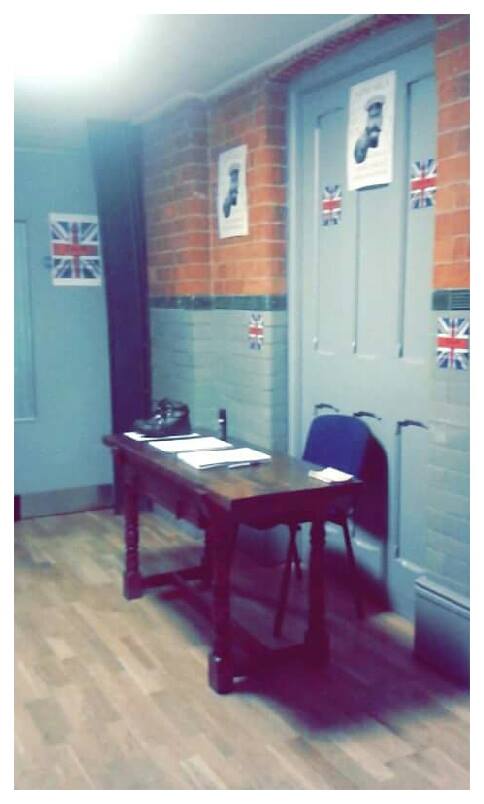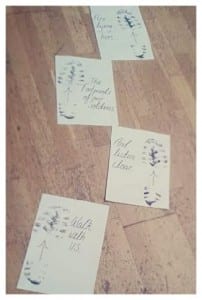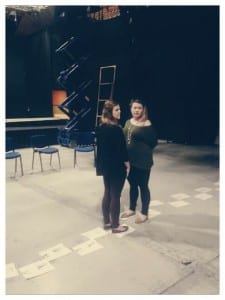‘We Need You And Your Footprints’
Framing Statement
‘We Need You and Your Footprints’ was created as a site-specific performance piece which was performed at The Lincoln Drill Hall on Free School Lane, Lincoln on Friday the 8th March 2015. The piece was an installation performance that lasted 16 minutes 40 seconds and was repeated twice in the 3 hour time slot at 2.30pm and 4.30pm.
The piece was constructed in the Main Auditorium of The Drill hall. As audience members/ the public entered the entrance of the building into the Reception/café area, they were invited by a poem on a trail of footprints down a corridor, which led to our space. They had to walk through two sets of double doors which were held open as to not shut the public out. Before entering the third set of double doors to our main space, we had a pre performance in the corridor where a station was set out. There was a table and one chair behind it, where I sat printing boot prints, surrounded by posters to look like a WW1 recruitment process. The public were invited to make their own print if they wished, and they then signed their name on the piece of paper with the print on. They were then asked to walk into the Auditorium space where as they turned to face the back wall, there was masking tape on the floor to mark out our area of installation, which already had some installed footprints. China and Laura then directed the public to replace an installed footprint from the taped area with their new footprint. The old footprint was then posted into a black post box and the members of the public were told they could feel free to come back for our performance times to watch our piece progress, or to continue through the auditorium to watch other groups performances if they wished.
Through the use of laying out approximately 500 footprints twice, it meant that 1000 pieces of paper were laid on the floor to represent 1000 soldiers in the 4th battalion who trained at The Drill Hall in the space of the auditorium. In the background of our piece was a projection on a cyclorama of a time lapse video of the old lighting rig being replaced by the new rig. On the video was also a countdown timer from 16 minutes 40 seconds. The footprints were placed in a grid with each piece of paper touching corners so we could step in between each gap to complete our tasks.
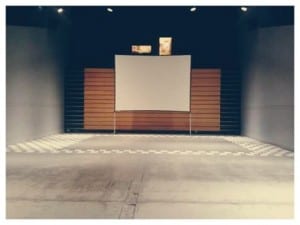
Baillie, L, (2015) Final layout.
Let the past meet the present as time counts down…
Our process was split into sections, the pre performance was of a recruitment like process inviting the audience to make a print whilst other prints were being laid out, a metaphor for the soldiers volunteering to join the Army. When the time-lapse video started and our countdown began our next section started, we scrunched up and down each row every footprint to represent the soldiers going to war and suffering physical and emotional pain, and the last section of flattening back out each footprint represented the soldiers returning home but having the memories and wounds with them, so they had changed throughout the process of war, which we represented through our installation. These 2 sections were in time with the “left- right” repetitive audio that was played for the duration of the 16 minutes 40 seconds to show the repetitive routines and drills and hard work that the soldiers endured.
Analysis of Process
Site Specific performance was first introduced to us by a task called ‘drifting’, where we had to recognise objects and thoughts we wouldn’t otherwise consider when walking to a destination. Whilst walking up and down a familiar path, by using my senses I started listening to the soundscapes of voices, the different tones and speeds and I started then to notice unusual sights by using my peripheral vision such as signposts which I had never seen and read the detail of. When I then first visited The Drill Hall I wanted to explore and research as much of the building’s history as I could as Mike Pearson states, “it is possible to be in a place without realising its significance for the groups of people who have historically inhabited it” (2007, 24).
First Encounters
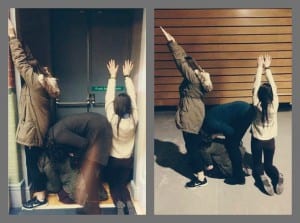
Baillie, L, (2015) Filling spaces and re creating the same image in a different space.
One of our first encounters with The Drill Hall involved us using inspiration from Willi Dorner. His piece ‘Bodies in Urban Spaces’ used bodies to fill unusual, unnoticed spaces as a performance, aiming that the interventions would provoke a thinking process (Cie Dorner, 2007). One task was to fill a space and then recreate this image in another space and see what it does to the space. We liked that every image we tried to recreate in the auditorium made our image look lost as the space was so big. Our final idea would then contrast this and fill the whole of this space.
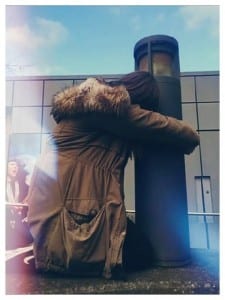
Baillie, L, (2015) Exploring body shapes.
We explored the site and experimented with unnoticed spaces and decided we liked the outside space. We then took photographs of ourselves in awkward, uncomfortable positions and this we felt looked really interesting, using our bodies in different positions to connect to the site. We then asked the rest of the class to copy our images and in a cycle they then all rotated, each completing every position with a countdown of 10 seconds to get into the each position. The idea of completing different tasks really intrigued us and we then realised it was almost like a drill.
In our next lesson we then developed this idea and like drill sergeants we commanded the class to complete a set of different exercises that physically challenged them, from abdominal crunches to push-ups. The use of using commands and physically challenging movements, inspired us decide to research into drills and it was from this moment that we made the decision to use the main auditorium as our space. From these first lessons we then formed our group of 3 as we all wanted to use audience interaction and have the drills as our focus for our piece as no other groups had chosen to explore the most obvious history of The Drill Hall.
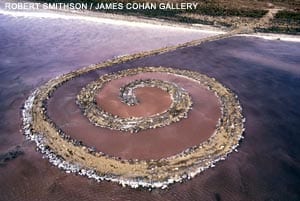
Smithson. R, (1970) Spiral Jetty.
Our First Ideas
We visited the Lincoln Archives where we came across information on the Volunteer Army, who trained at the Drill Hall, also known as the 4th Battalion Lincolnshire Regiment. They took place in many drill competitions, such as marching in space of what is now the auditorium. We didn’t want to re-enact the drills as we thought about the idea of representing drills but through an installation. From one of the first lessons after seeing Robert Smithson’s large-scale construction Spiral Jetty (1970), I was interested in making an installation as I wanted to connect to the site through a style I had never experimented with to create an eye catching piece. At the Archives we also came across some recruitment posters which inspired my artistic side.
We were drawn to the number on the poster that said ‘300,000 more men’ which made us look at how we could use specific numbers to create an installation.
Incorporating the idea of tasks, my interest in paint/art and the use of senses, including smell by Laura’s interest in boot polishing…

Baillie, L, (2015) Footprint first tests.
The idea
The idea then created was to make boot prints from boot polish, to install in the auditorium to represent how many men trained in The Drill Hall Volunteer Army.
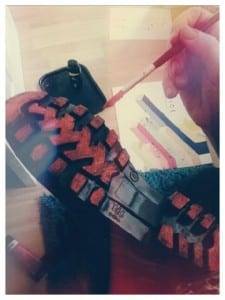
Baillie, L, (2015) Paint Experiments.
A diagram which stated “Battalion: 1000 men commanded by Lt Colonel” (Lincolnshire.gov.uk, 2015), then made us know that we needed 1000 boot prints to represent the number of Soldiers in a battalion, which was similar to Stan’s Café ‘Of All The People In All The World’, an installation which “uses grains of rice to bring formally abstract statistics to startling and powerful life” (Stan’s Cafe, 2014). I made some prints to see what they looked like and how we could create meaning. I liked the idea of having them in lines to look like drills as soldiers would step left then right in a straight line when marching.
From my first experiment with black and red footprints we came to the conclusion that we needed to have gaps in between the footprints for us to be able to walk safely and without moving the positioned prints when performing. We then decided to only use black prints as the colour red was to signify the death of the men in the 4th battalion and our piece was about bringing back to life the memories of the soldiers who trained in the drill hall focussing on the 1000 soldiers who were alive at the time they were in the site.
Research and Influences
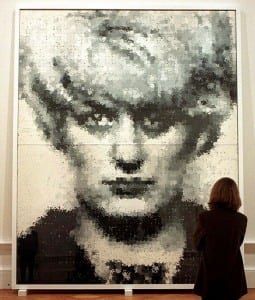
Daily Mail, (20108) Myra Hindley Portrait.
Following my interest in art and the idea about laying lots of footprints down we thought about creating a lasting image. I then realised this was like an artwork that was made in 1995, the portrait of Myra Hindley. The painting caused a lot of controversy due to the juxtaposition of innocent children’s hands and the face of a not so innocent adult. However the image is very memorable which is what we want to create but of course the message behind our image won’t relate to anything controversial, it would relate to the themes of our piece, paying our respects to the soldiers.
The Fleur de lis, a stylised lily shape, is the Lincolnshire coat of arms and is engraved in the architecture in the café in The Drill Hall. We thought about using this as our lasting image which we would create out of the 1000 footprints, however although we thought it would show our respect to the 4th Battalion we wanted to represent the soldiers who were alive and trained in our space and a shape of a lily would connote death.
We looked at Rajni Shah but we could not find the initial piece we were looking for and came across instead a project called ‘Glorious’. Although this piece was not site specific we were inspired by the audience involvement by being invited to place a daffodil on the stage. This inspired our idea of audience interaction by inviting the audience to lay a footprint in our installation.
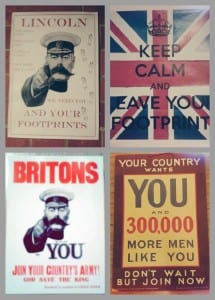
Baillie, L, (2015) Posters-top row our own, bottom row from the Lincolnshire Museum of Life and Lincoln Archives
After watching The Passion of Port Talbot (2011), a modern retelling of the Easter Story, lasting over 72-hours created by one community, it made me realise how much thought, time and effort needs to go in to making a site specific piece, and also what actually is meant by site specific. Creating a piece built on the lives or events that happened in a specific place and the involvement of the community played a big part. We then decided on the duration of our piece to further represent 1000 soldiers with 1000 footprints and have our piece last 1000 seconds, which equates to 16 minutes, 40 seconds.
We then researched Lone Twin, a theatre company who’s “early duo pieces were intentionally arduous and physically demanding…They gathered round and tried to help. Ever since, that’s what we’ve been doing – encouraging people to gather around” (lonetwin.com). The Boat Project involved the creation of a boat formed from pieces of wood that members of the community were asked to contribute to and leave at a drop off point. It was from here that we decided that we could link in our idea of posters and a recruitment process so each member of the public who visited The Drill Hall was invited to make a print and also sign their name on the print, to leave their mark on the site. This was our pre performance idea.
Development of idea
We tried out laying rows of prints across the top of each other to represent a different journey of a soldier but from the Archives we couldn’t find as much as we’d hoped about individual soldiers so we wanted to stick with the regimented structure of straight lines.
We then tested out the speed in which we would lay the prints to see whether it would look more impacting fast or slow. I practised reading out WW1 poems “The Call” and “Dulce Decorum est” whilst Laura and China laid out the footprints keeping up with my pace. We tried different starting positions but decided we wanted to start in a line to all fulfil the task in unison so that by the end you could see the individual physical challenges we faced if we became out of sync.We felt the experiments of poems didn’t match our movement. A countdown clock which kept us more in time with each other when laying the prints was then tried. This then engineered our idea to again link back to the drill idea and use the commands ‘left, right, left right’. We wanted an audio on loop that also “repeats on individual lines” (Forced Entertainment), so we decided to have two simple words to parallel with our repetitive movements of laying the footprints.
(“Left, Right” Audio)
We did though keep the idea of poetry and we decided to make up our own poems to not only invite the audience in to follow them to our space, but also they gave a slight hint about what our piece was about.
“walk with us and listen clear, the footprints of our soldiers are lying here”
“You may wish to leave, but feel free to stay, our piece will progress, so return through the day” (Baillie et al, 2015)
Due to the few different styles of poems; one being about signing up to war, one going to war and the other returning to war we decided we could use this as inspiration and represent different stages of war with the footprints rather than just simply lay them out.
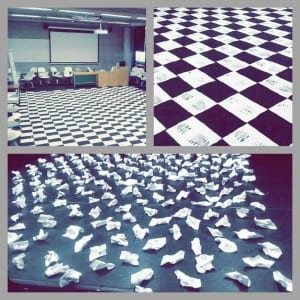
Baillie, L, (2015) Rehearsals of 3 stages.
Laying the prints= training,
Scrunching the prints= going to war the wear and tear
Flattening the prints= returning but being a changed man.
“Kaprow “sought to disrupt the Aristotelian unities of place, time and action within performance and suggested that the happening should be dispersed…”” (Govan, 2007, 120).
Final Rehearsals
We practised laying the footprints out fully with the 3 stages. It took more than 16 minutes and 40 seconds to lay the prints, scrunch them up and then flatten them!
CHANGE OF PLAN
Because our piece was all about the meaning of time we had to decide what to do to fit it all in as we wanted to still represent all 3 stages. We decided that part of our pre performance would now be laying out the footprints, so before we start our countdown timer all the prints would be laid out.
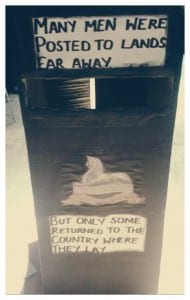
Baillie, L, (2015) Post Box.
We then had another idea to make a post box and the audience would post an old footprint in the box marked ‘Egypt’ as the battalion were sent to war. The meaning for the box would tie in with the collection of the election votes that happened in the auditorium on Thursday 7th May, the night before our performance. The act of posting a piece of important paper that decides the future, was a metaphor of the soldiers’ lives we were representing though footprints.
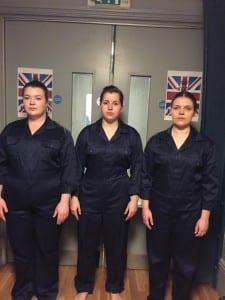
Boughen, L, (2015) Costumes.
We then decided on our costumes to be navy blue overalls as we didn’t want to be the soldiers, nor did we want to be technicians our initial idea to look like we were also fitting an installation like the technicians installing the rig on our video. The overalls were neutral and representing us as general workers.
During a rehearsal at the LPAC, we decided to practice laying out the footprints and recording a time-lapse, as we had watched a video of the fitting of the new lighting rig in the auditorium. We chose to then use this video in our performance to juxtapose our new installation in the same site and show how another installation was fitted.
Evaluation
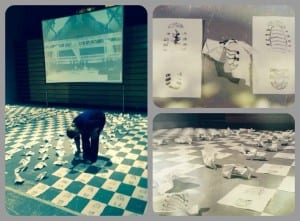
Baillie, L, (2015) Final 3 stages of prints.
Our performance went well on the day; we were worried about the timing. Nonetheless I feel we showed the key to our piece was shown through our idea of time and numbers. I was physically drained during and after each performance, from feeling sick, sweating, cramping, to feeling faint. I can’t imagine how hard it must have been to be a soldier and have to endure even tougher tasks than we did in our space.
Our scrunching started in time to the quick paced audio but as the cycle progressed by the time we were flattening the footprints we were all at different paces. At first I thought this may look messy and lose the meaning of our piece, being regimented like a drill would have been, but we then realised that actually it added more meaning to our piece by showing that as human beings and soldiers, every person is of a different ability. I was left struggling more than the others towards the end, almost having to pick my legs up with my hands to keep going, but I did manage to still flatten every print and complete the tasks before the time was up.
If we were to perform it again I think the pre performance could be more structured as the public struggled to understand that they were to replace an existing footprint with their new print and that they could come and return as they desired. Large signs with clear directions on them would have been better so we didn’t need to talk to them as we were supposed to be neutral. I also think that the three of us should all have been printing during the time gaps between each performance so we looked more regimented rather than too casual standing around.

Baillie, L, (2015) Recruitment Station.
Some members of the public decided to watch the full 16 minutes 40 seconds and we hope this made them appreciate the strenuous tasks we were undertaking. Whilst watching the time lapse video on a loop as well as listening to the repetitive audio they must have been intrigued by our commitment to interacting with every single piece of paper. We could have made the public stay for the full duration, but I feel that they should choose when they want to be an audience member and feel they have endured as much as they want to see, as they were not on a time constraint like us.
I would have liked to have filled the whole auditorium with footprints to make an even greater visual impact on the space. However, the specific use of time to symbolise the soldiers may have then been lost and it would have had to have been a slower process to physically be able to fill the whole hall, so the preciseness of 1000 footprints, in 1000 seconds for 1000 men, would not have been as powerful. Adding the soldiers’ names to the footprints could have made our piece more specific to our site and link the past to the present even more.
Overall, I feel we bought a new appearance to The Drill Hall and bought a different “experience where you enter into a space and witness things you wouldn’t otherwise”(Hillier,). We bought the past with the present in an interesting visually stimulating way. Our piece has made me appreciate the soldiers we were representing and opened my eyes up to the ways in which site specific performance can be very challenging but open up so many doors to appreciating spaces that can be transformed into anything you want them to. As Mike Pearson explains “the manipulation of the material landscape and its own right, the artist adding, removing or displacing materials- marking, cutting, rearranging” which I feel is what we did by integrating all of our ideas, metaphorically and literally by the processes that the footprints endured, created a site specific performance.
Works Cited
Baillie, L., Boughen, L. and Pacey, C. (2015) We Need You and Your Footprints. [performance] Lincoln: Lincoln Drill Hall, 8th May.
Cie Willi Dorner. Bodies in urban spaces. [online] Available from http://www.ciewdorner.at/index.php?page=start [Accessed on 12 February 2015].
DailyMail. (2008) Myra Hindley Portrait. [image] Available from http://www.dailymail.co.uk/news/article-1048910/Fury-image-Myra-Hindley-appears-Best-British-film-2012-Olympics-party.html [Accessed 10 March 2015].
Davies, D. (2015) Left, Right Clip. [sound].
Forced Entertainment (2013) Forced Entertainment: A Broadcast / Looping Pieces. [online]Available from http://www.forcedentertainment.com/project/a-broadcastlooping-pieces/ [Accessed 22 February 2015]
Govan, E., Nicholson, H. and Normington, K. (2007) Making a Performance: Devising Histories and Contemporary Practices. Oxon: Routledge.
Grimshaw, O. (2015) Time Lapse Performance Video. [Video].
Lincolnshire.gov.uk, (2015). Royal Lincolnshire Regiment During World War I | Lincolnshire County Council. [online] Available from http://www.lincolnshire.gov.uk/residents/archives/collections/guides-to-sources/royal-lincolnshire-regiment-during-world-war-i/118960.article [Accessed 12 May 2015].
Lone Twin: About Us. Available from http://www.lonetwin.com/ [Accessed 9 March 2015].
Mike Hurley (2012) Stop Motion Rig [online video] Available from http://www.lincolndrillhall.com/about-us/the-venue-its-history [Accessed 13 May 2015].
Pearson, M. (2010) Site Specific Performance. Basingstoke: Palgrave Macmillan.
Smithson, R. (1970) Earth Works: Spiral Jetty [image]Available from http://www.robertsmithson.com/earthworks/spiral_jetty.htm [Accessed 12 February 2015].
Stan’s Cafe (2014) Of All The People In All The World [online] Available from http://www.stanscafe.co.uk/project-of-all-the-people.html [Accessed 14 May 2015].
